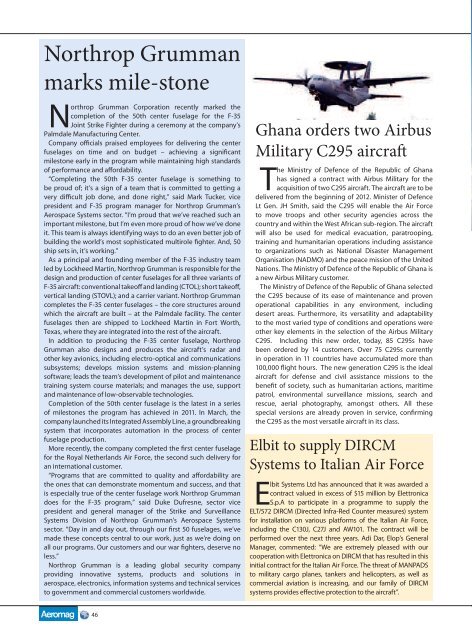July-August 2011 - Aeromag
July-August 2011 - Aeromag
July-August 2011 - Aeromag
Create successful ePaper yourself
Turn your PDF publications into a flip-book with our unique Google optimized e-Paper software.
Northrop Grumman<br />
marks mile-stone<br />
T-50 stealth<br />
fighter makes<br />
Northrop Grumman Corporation recently marked the<br />
completion of the 50th center fuselage for the F-35<br />
Joint Strike Fighter during a ceremony at the company’s<br />
Palmdale Manufacturing Center.<br />
Company officials praised employees for delivering the center<br />
fuselages on time and on budget – achieving a significant<br />
milestone early in the program while maintaining high standards<br />
of performance and affordability.<br />
“Completing the 50th F-35 center fuselage is something to<br />
be proud of; it’s a sign of a team that is committed to getting a<br />
very difficult job done, and done right,” said Mark Tucker, vice<br />
president and F-35 program manager for Northrop Grumman’s<br />
Aerospace Systems sector. “I’m proud that we’ve reached such an<br />
important milestone, but I’m even more proud of how we’ve done<br />
it. This team is always identifying ways to do an even better job of<br />
building the world’s most sophisticated multirole fighter. And, 50<br />
ship sets in, it’s working.”<br />
As a principal and founding member of the F-35 industry team<br />
led by Lockheed Martin, Northrop Grumman is responsible for the<br />
design and production of center fuselages for all three variants of<br />
F-35 aircraft: conventional takeoff and landing (CTOL); short takeoff,<br />
vertical landing (STOVL); and a carrier variant. Northrop Grumman<br />
completes the F-35 center fuselages – the core structures around<br />
which the aircraft are built – at the Palmdale facility. The center<br />
fuselages then are shipped to Lockheed Martin in Fort Worth,<br />
Texas, where they are integrated into the rest of the aircraft.<br />
In addition to producing the F-35 center fuselage, Northrop<br />
Grumman also designs and produces the aircraft’s radar and<br />
other key avionics, including electro-optical and communications<br />
subsystems; develops mission systems and mission-planning<br />
software; leads the team’s development of pilot and maintenance<br />
training system course materials; and manages the use, support<br />
and maintenance of low-observable technologies.<br />
Completion of the 50th center fuselage is the latest in a series<br />
of milestones the program has achieved in <strong>2011</strong>. In March, the<br />
company launched its Integrated Assembly Line, a groundbreaking<br />
system that incorporates automation in the process of center<br />
fuselage production.<br />
More recently, the company completed the first center fuselage<br />
for the Royal Netherlands Air Force, the second such delivery for<br />
an international customer.<br />
“Programs that are committed to quality and affordability are<br />
the ones that can demonstrate momentum and success, and that<br />
is especially true of the center fuselage work Northrop Grumman<br />
does for the F-35 program,” said Duke Dufresne, sector vice<br />
president and general manager of the Strike and Surveillance<br />
Systems Division of Northrop Grumman’s Aerospace Systems<br />
sector. “Day in and day out, through our first 50 fuselages, we’ve<br />
made these concepts central to our work, just as we’re doing on<br />
all our programs. Our customers and our war fighters, deserve no<br />
less.”<br />
Northrop Grumman is a leading global security company<br />
providing innovative systems, products and solutions in<br />
aerospace, electronics, information systems and technical services<br />
to government and commercial customers worldwide.<br />
Ghana orders two Airbus<br />
Military C295 aircraft<br />
The Ministry of Defence of the Republic of Ghana<br />
has signed a contract with Airbus Military for the<br />
acquisition of two C295 aircraft. The aircraft are to be<br />
delivered from the beginning of 2012. Minister of Defence<br />
Lt Gen. JH Smith, said the C295 will enable the Air Force<br />
to move troops and other security agencies across the<br />
country and within the West African sub-region. The aircraft<br />
will also be used for medical evacuation, paratrooping,<br />
training and humanitarian operations including assistance<br />
to organizations such as National Disaster Management<br />
Organisation (NADMO) and the peace mission of the United<br />
Nations. The Ministry of Defence of the Republic of Ghana is<br />
a new Airbus Military customer.<br />
The Ministry of Defence of the Republic of Ghana selected<br />
the C295 because of its ease of maintenance and proven<br />
operational capabilities in any environment, including<br />
desert areas. Furthermore, its versatility and adaptability<br />
to the most varied type of conditions and operations were<br />
other key elements in the selection of the Airbus Military<br />
C295. Including this new order, today, 85 C295s have<br />
been ordered by 14 customers. Over 75 C295s currently<br />
in operation in 11 countries have accumulated more than<br />
100,000 flight hours. The new generation C295 is the ideal<br />
aircraft for defense and civil assistance missions to the<br />
benefit of society, such as humanitarian actions, maritime<br />
patrol, environmental surveillance missions, search and<br />
rescue, aerial photography, amongst others. All these<br />
special versions are already proven in service, confirming<br />
the C295 as the most versatile aircraft in its class.<br />
Elbit to supply DIRCM<br />
Systems to Italian Air Force<br />
Elbit Systems Ltd has announced that it was awarded a<br />
contract valued in excess of $15 million by Elettronica<br />
S.p.A to participate in a programme to supply the<br />
ELT/572 DIRCM (Directed Infra-Red Counter measures) system<br />
for installation on various platforms of the Italian Air Force,<br />
including the C130J, C27J and AW101. The contract will be<br />
performed over the next three years. Adi Dar, Elop’s General<br />
Manager, commented: “We are extremely pleased with our<br />
cooperation with Elettronica on DIRCM that has resulted in this<br />
initial contract for the Italian Air Force. The threat of MANPADS<br />
to military cargo planes, tankers and helicopters, as well as<br />
commercial aviation is increasing, and our family of DIRCM<br />
systems provides effective protection to the aircraft”.<br />
public debut<br />
T-50 stealth fighter jointly<br />
developed by Russia and India<br />
made its first international public<br />
appearance at the recent MAKS airshow,<br />
where Moscow unveiled its newest space<br />
shuttle, armed drones and a new range<br />
of upgraded weapons. Two prototypes<br />
of the single seater jet, estimated to cost<br />
USD 6 billion, flew over Zhukovsky air field<br />
on the outskirts of Moscow.<br />
“The co-development projects of the<br />
two countries will remain centerpiece of<br />
the Russian aviation industry”, declared<br />
Mikhail Pogosyan, President of the United<br />
Aircraft Corporation, makers of the<br />
aircraft.<br />
Sukhoi’s T-50 made its maiden flight<br />
in January 2010 and is expected to enter<br />
service by 2015. “The stealth fighter is<br />
progressing as planned and the new<br />
engine for the plane will be ready in time”,<br />
Pogosyan said.<br />
The fifth generation Sukhoi T-50,<br />
also called the PAK FA for its Russian<br />
abbreviations for a perspective frontline<br />
aviation complex, is meant to be a rival to<br />
the US joint strike fighter F-22 Raptor.<br />
Pogosyan had earlier said that Russia<br />
planned to develop up to 1,000 stealth<br />
fighters over the coming decade as<br />
aviation experts say that the Russian<br />
military orders will account for more<br />
than 50 per cent of the combat planes’<br />
produce.<br />
He said that the Russian Air Force is<br />
expected to buy 20 new fighters annually<br />
in the coming years.<br />
Top Russian aircraft makers including<br />
Sukhoi and MiG have survived thanks to<br />
orders from India and China, but steady<br />
increase in government defence spending<br />
over the past few years have given<br />
new incentives to the nation’s aircraft<br />
industries.<br />
According to the local media reports, the<br />
Indian version of the FGFA will be a lighter<br />
derivative of the PAK FA.<br />
The projects for the joint development<br />
of Multimode Transport Aircraft (MTA) and<br />
deeper modernisation of Sukhoi Su-30<br />
MKI fighters under the ‘Super-30” project<br />
are among the key joint Indo-Russian<br />
projects.<br />
India has a larger footprint at MAKS-<strong>2011</strong>,<br />
the air show which is held at alternate<br />
years, with an expanded presence.<br />
Unlike in the past when BrahMos JV used<br />
to display its deadly missiles under the<br />
roof of its Russian partner, India has its<br />
exclusive stall displaying the models of its<br />
cruise missiles, including an outdoor lifesize<br />
mock-up of BRAHMOS cruise missile<br />
for the Sukhoi fighters.<br />
Hindustan Aeronautics Limited also has<br />
a bigger display exhibiting models of the<br />
helicopters and planes produced by it.<br />
This year’s new entrant is Bharat<br />
Electronics, with a whole range of its<br />
avionics and force multipliers.<br />
A huge IL-76 Flying Laboratory of<br />
Gromov Flight Research Institute with<br />
a Kaveri engine fitted on its test bed is<br />
also indicative of the scope of bilateral<br />
cooperation in cutting edge technologies.<br />
The plane also bears the Seal of India’s<br />
DRDO, showing an enduring interaction<br />
between the two organisations.<br />
In all, over 800 Russian and foreign firms,<br />
including Boeing and Airbus, took part in<br />
MAKS airshow.<br />
MBDA unveils<br />
concept missile<br />
system<br />
MBDA has unveiled the output<br />
of the Concept Visions process<br />
for <strong>2011</strong>; CVS 401 Perseus<br />
concept missile system, which represents<br />
the group’s vision of a multi-role strike<br />
weapon system for 2030 and beyond.<br />
Perseus features multiple operating<br />
modes against a wide land and maritime<br />
target set with the added capability<br />
of being able to overcome the most<br />
effective of enemy missile defences.<br />
It is designed to be a tactical weapon<br />
system operated through an advanced<br />
Operations & Mission Planning System<br />
at the crossroads of naval, land and air<br />
warfare. The advanced supersonic (up<br />
to Mach 3), agile and stealthy airframe<br />
is powered by a revolutionary ramjet<br />
motor built around a highly compact<br />
Continuous Detonation Wave Engine.<br />
An advanced dual-mode sensor package,<br />
comprising an Active Electronically-<br />
Scanned Array or AESA radar combined<br />
with a laser radar or LADAR allows for allweather<br />
operations in all configurations<br />
of terminal engagement. Radar modes<br />
such as SAR (Synthetic Aperture Radar)<br />
and DBS (Doppler Beam Sharpening)<br />
allow for long range target detection and<br />
discrimination in complex land and naval<br />
tactical environments including those<br />
involving advanced counter measures.<br />
A e r o m a g 46<br />
A e r o m a g 47




